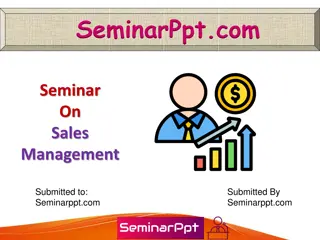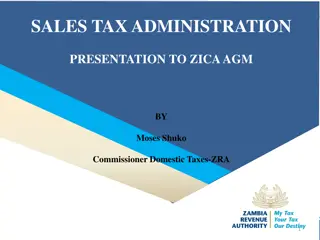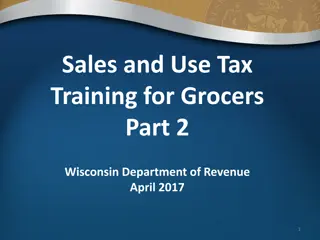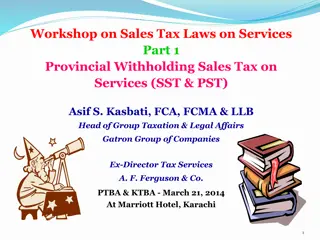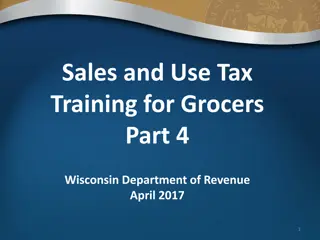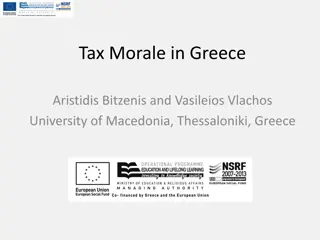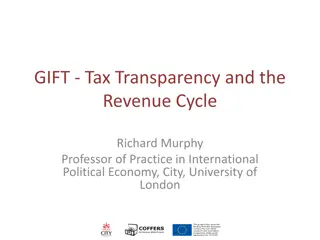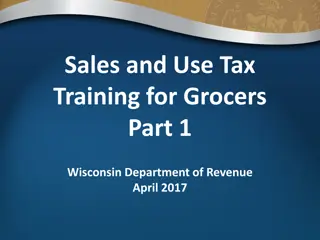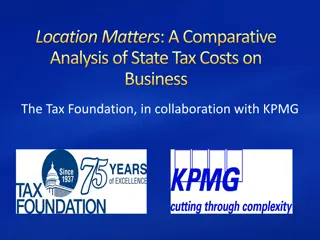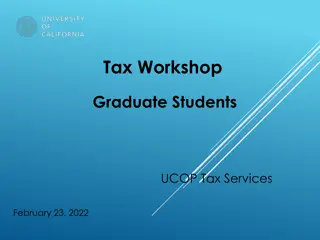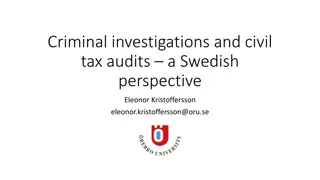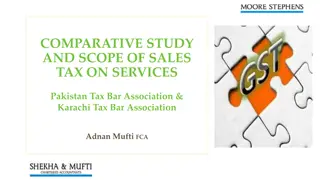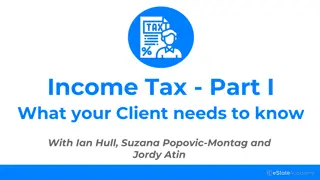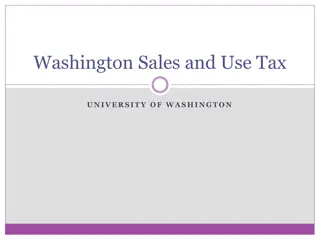Sales and Use Tax for Grocers in Wisconsin
This training material provides essential information on sales and use tax guidelines for grocers in Wisconsin. Topics covered include the sales of prepared foods, exemptions for food and food ingredients, and identifying prepared foods in grocery sales. The content emphasizes the distinction between taxable and nontaxable food items to help grocers comply with tax regulations effectively.
Download Presentation

Please find below an Image/Link to download the presentation.
The content on the website is provided AS IS for your information and personal use only. It may not be sold, licensed, or shared on other websites without obtaining consent from the author.If you encounter any issues during the download, it is possible that the publisher has removed the file from their server.
You are allowed to download the files provided on this website for personal or commercial use, subject to the condition that they are used lawfully. All files are the property of their respective owners.
The content on the website is provided AS IS for your information and personal use only. It may not be sold, licensed, or shared on other websites without obtaining consent from the author.
E N D
Presentation Transcript
Sales and Use Tax Training for Grocers Part 3 Wisconsin Department of Revenue April 2017 1
Topics of Discussion Sales of Prepared Foods Prepared Food Flow Chart 2
Additional Training for Grocers Part 1 Sales by Grocers Part 2 - Sales of Candy, Soft Drinks, and Dietary Supplements Part 4 - Preparing for an Audit 3
Sales of Prepared Foods 4
Exemption for Food and Food Ingredients The sales price from the sale of and the storage, use, or other consumption of food and food ingredients, except: Candy (see Part 2) Soft drinks (see Part 2) Dietary supplements (see Part 2) Prepared food 5
Food and Food Ingredient A substance in liquid, concentrated, solid, frozen, dried, or dehydrated form, that is sold for ingestion, or for chewing, by humans and that is ingested or chewed for its taste or nutritional value does not include alcoholic beverages or tobacco. 6
Food and Food Ingredient Food and food ingredients include beverages, but not alcoholic beverages (0.5% or more alcohol by volume). Alcoholic beverages are taxable. 7
Prepared Food Most restaurant sales are taxable as prepared food. Most grocery store sales are not prepared foods, although some are likely to be prepared food. 8
Step 1 - Prepared Food Includes Test 1: Food or food ingredient sold in a heated state (above room temp). Hot coffee Rotisserie chicken Burgers, hot dogs, French fries, pizza If customer places unheated item in microwave and heats, the item is not sold in a heated state. 9
Step 1 - Prepared Food Includes Test 2: It is the retailer's customary practice to physically give or hand customer a utensil with the item ("utensil" includes napkins, cups, spoons, straws, forks, knives, plates, bowls, and glasses). Retailer gives customer a straw with a bottle of water Retailer gives customer a napkin with a doughnut Still "prepared food," even if customer doesn't take utensil. Making utensils available is not the same as physically giving or handing a utensil to customer with food (e.g., napkin dispenser). 10
Step 1 - Prepared Food Includes Test 3: When plates, bowls, glasses, or cups necessary to receive the item are made available to customer. Customer gets milk from a dispenser and cups are available (cup necessary to receive, even if customer brings his own cup) Retailer or customer scoops ice cream into a bowl 11
Step 1 - Prepared Food Includes Test 4: Package contains a utensil placed in it by someone (nonmanufacturer) other than the retailer. Food wholesaler puts a fork in a container of sliced fruit; wholesaler sells container to retailer; retailer's sale to customer is a sale of "prepared food" 12
Step 2 - Prepared Food Includes Test 5: Food and food ingredients that were previously heated by the retailer, but sold in unheated state, if the retailer mixed or combined 2 or more ingredients and sold as a single item. Exception: Go to the 75% test, if any of the following: Retailer's primary NAICS code is manufacturing (but not a bakery or tortilla manufacturer) OR Item is sold by weight or volume OR Item sold is a bakery item 13
What is the 75% Test? If food or food ingredient meets any of Tests 1- 4, it is prepared food (taxable). If food or food ingredient meets any of Tests 5 - 6, it is prepared food (taxable), unless one of the exceptions apply. If an exception applies, we must use the 75% test. 14
What is the 75% Test? The 75% is calculated as follows: retailer's sales of certain prepared food retailer's sales of all food and food ingredients 15
Step 2 - Prepared Food Includes Test 5: Food and food ingredients that were previously heated by the retailer, but sold in unheated state, if the retailer mixed or combined 2 or more ingredients and sold as a single item. Exception: Go to the 75% test, if any of the following: Retailer's primary NAICS code is manufacturing (but not a bakery or tortilla manufacturer) OR Item is sold by weight or volume OR Item sold is a bakery item 16
Step 2 - Prepared Food Includes Test 6: When the retailer did not previously heat the food and food ingredients, but mixed or combined 2 or more ingredients and sold as a single item. Exception: Go to the 75% test, if any of the following: Retailer's primary NAICS code is manufacturing (but not a bakery or tortilla manufacturer) OR Item is sold by weight or volume OR Item sold is a bakery item OR Retailer only slices, repackages, or pasteurizes item OR Item contains meat, fish, egg, or poultry in raw form that requires cooking by the consumer 17
What is the 75% Test? 75% Test: If the retailer's sales of certain prepared foods is greater than 75% of its sales of all food and food ingredients, all of the retailer's sales of food and food ingredients are sales of prepared food (taxable) if utensils are made available by the retailer to the purchaser. 18
What is the 75% Test? Exception: If the item contains 4 or more servings packaged as 1 item and sold for a single price, that item is not prepared food (unless it meets any of Tests 1 4). Serving sizes are based on the information contained on the label of each item sold, except that if the item does not contain a label, the serving size is based on the retailer s reasonable determination. 19
What is the 75% Test? If utensils are not made available by the retailer to the purchaser, the items listed as exceptions in Tests 5 and 6 are not prepared food (unless they meet one of the tests in Test 1 4). 20
Prepared Food Example 1 Grocery's bakery department makes donuts The donuts are sold for $0.75 each The donuts are not sold heated The grocery store/bakery's customary practice is not to give or hand a utensil to its customers with donuts Plates, bowls, glasses, or cups are not necessary to receive the donut The grocery store's sales of prepared foods are less than 75% The donut is not a prepared food and is not subject to sales tax 21
Prepared Food Example 2 Grocery's deli department prepares and sells cold, ready- to-eat sandwiches The sandwiches are sold for $3.25 each The deli mixes or combines 2 or more ingredients for sale as a single item The sandwiches are not sold by weight or volume The sandwich is not a bakery item The deli does more than slice, repackage, or pasteurize the sandwich ingredients The sandwich does not contain egg, fish, meat, or poultry or any food containing them in raw form which requires further cooking to prevent food-borne illnesses The sandwich is a prepared food and is subject to sales tax 22
Additional Training for Grocers Part 1 Sales by Grocers Part 2 - Sales of Candy, Soft Drinks, and Dietary Supplements Part 4 - Preparing for an Audit 23
Contact DOR if you have questions WISCONSIN DEPARTMENT OF REVENUE Customer Service Bureau PO Box 8949, MS 5-77 Madison, WI 53708-8949 Phone: (608) 266-2776 Email: DORSalesandUse@wisconsin.gov 24






